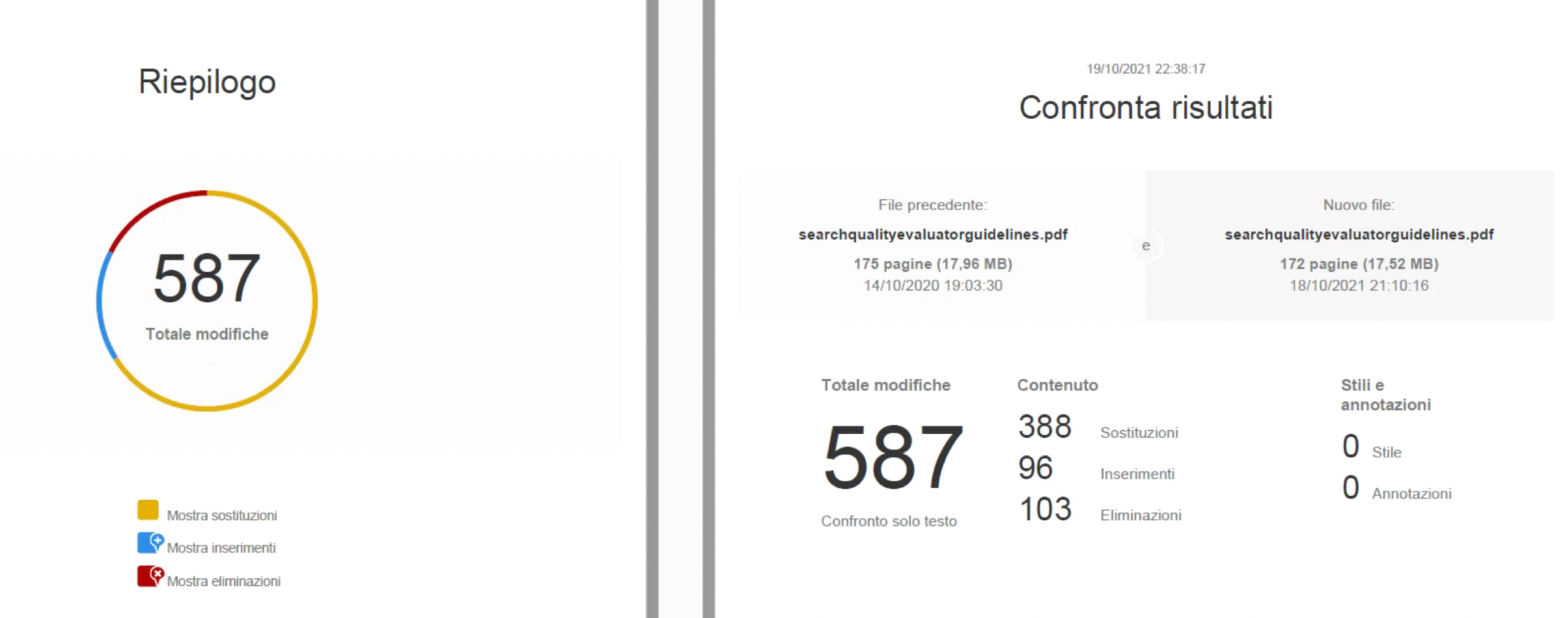- Home
- Categorie
- Digital Marketing
- SEO
- Aggiornate dopo più di un anno le linee guida per i Quality Raters
-
Aggiornate dopo più di un anno le linee guida per i Quality Raters
Dopo poco più di un anno, le linee guida per i Quality Raters di Google vengono aggiornate!
Il PDF (accessibile a tutti) che potete trovare a questo indirizzo https://static.googleusercontent.com/media/www.google.com/en//insidesearch/howsearchworks/assets/searchqualityevaluatorguidelines.pdf... riporta la data di oggi 19 Ottobre 2021.
Ho analizzato un po' tutte le differenze rispetto al precedente PDF. Interessante come il termine USERS viene rimpiazzato spesso con PEOPLE
 (sembra essere ritornati indietro di almeno 7/8 anni, quando già si parlava di chiamarle persone anziché utenti
(sembra essere ritornati indietro di almeno 7/8 anni, quando già si parlava di chiamarle persone anziché utenti  )
)Tra le modifiche più significative (forse):
-
Viene aumentata le definizione di gruppi di persone sul capitolo YMYL pages
[Precedente]: "race or ethnic origin, religion, disability, age, nationality, veteran status, sexual orientation, gender or gender identity."
[Nuovo]: "age, caste, disability, ethnicity, gender identity and expression, immigration status, nationality, race, religion, sex/gender, sexual orientation, veteran status, victims of a major violent event and their kin, or any other characteristic that is associated with systemic discrimination or marginalization." -
Aggiornamento sulla ricerca delle informazioni sulla "bio" dei content creators e della reputazione dei siti web (questo molto interessante)
[Nuovo, aggiunto]: "An important part of PQ rating is understanding the reputation of the website. If the creator of the MC is different from the creator of the website, it's important to understand the reputation of the creator as well." -
Aggiornata e riorganizzata completamente la sezione che definisce la pagine di bassa qualità (quindi anche testo copiato, spammoso ecc.). Tanto roba da leggere qui perché è veramente stata "stravolta" la sezione. Cito giusto un piccolo pezzo. Evito di inserire le modifiche perché sono veramente tantissime. Prendo giusto questo sotto capitolo:
7.5.5 How to Determine if Content is Copied
[...]
-1. Copy a sentence or phrase in the text. It may be necessary to try a few sentences or phrases from the page just to be sure. When deciding what sentence or phrase to copy, try to find a sentence or series of several words without punctuation, unusual characters, or suspicious words that may have replaced the original text.
-2. Search on Google by pasting the sentence or phrase (surrounded by quotation marks to search for an exact match) inside the Google search box. You may also try without quotation marks to search for more general matches.
-3. Compare the pages you find that match the sentence or phrase. Is most of their MC the same? If so, does one clearly come from a highly authoritative source that is known for original content creation (newspaper, magazine, medical foundation, etc.)? Does one source seem to reasonably be the original? Does one source appear to have the earliest publication date, verified by sources like the Wayback Machine?
[...] -
Semplificato (di brutto) la tabella dedicata ai contenuti da segnalare come offensivi "Upsetting-Offensive"
[Nuovo]: "Mark content that may be upsetting or offensive from the perspective of a typical user in your locale as Upsetting-Offensive , keeping in mind that people of all ages, genders, races, religions, and political affiliations use the Internet to understand the world and other points of views. Mark content that may be unpleasant or uncomfortable for some people in your locale"
Anche qui molta attenzione alle persone, meno alla keyword

Queste le principali che ho potuto vedere (anche grazie al riassunto inserito nelle linee guida sul che cosa cambia in questa versione di Ottobre 2021).
Nei prossimi giorni approfondirò

Spero sia utile a tutti
Buona SEO
-
-
Giusto per completezza (per chi ama le statistiche) vi incollo lo screen del match tool del PDF


1 Risposta
-
Ciao @filipposogus
grazie mille per la condivisione.
-
Grande @filipposogus

Me le spulcerò!
-
@filipposogus ha detto in Aggiornate dopo più di un anno le linee guida per i Quality Raters:
Giusto per completezza (per chi ama le statistiche) vi incollo lo screen del match tool del PDF

@filipposogus cosa usi per fare i confronti?
1 Risposta
-
@aledandrea ha detto in Aggiornate dopo più di un anno le linee guida per i Quality Raters:
@filipposogus ha detto in Aggiornate dopo più di un anno le linee guida per i Quality Raters:
Giusto per completezza (per chi ama le statistiche) vi incollo lo screen del match tool del PDF

@filipposogus cosa usi per fare i confronti?
Ciao @aledandrea, in questo caso ho usato Adobe Acrobat PRO DC > Vista > Strumenti > Confronta File > Apri.
